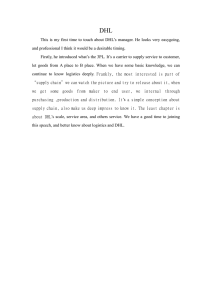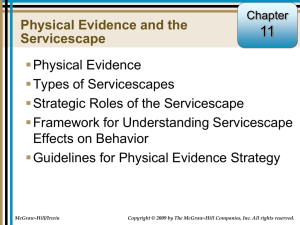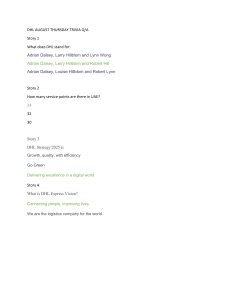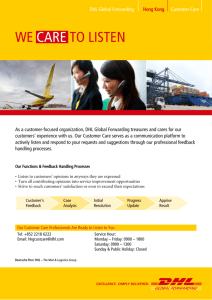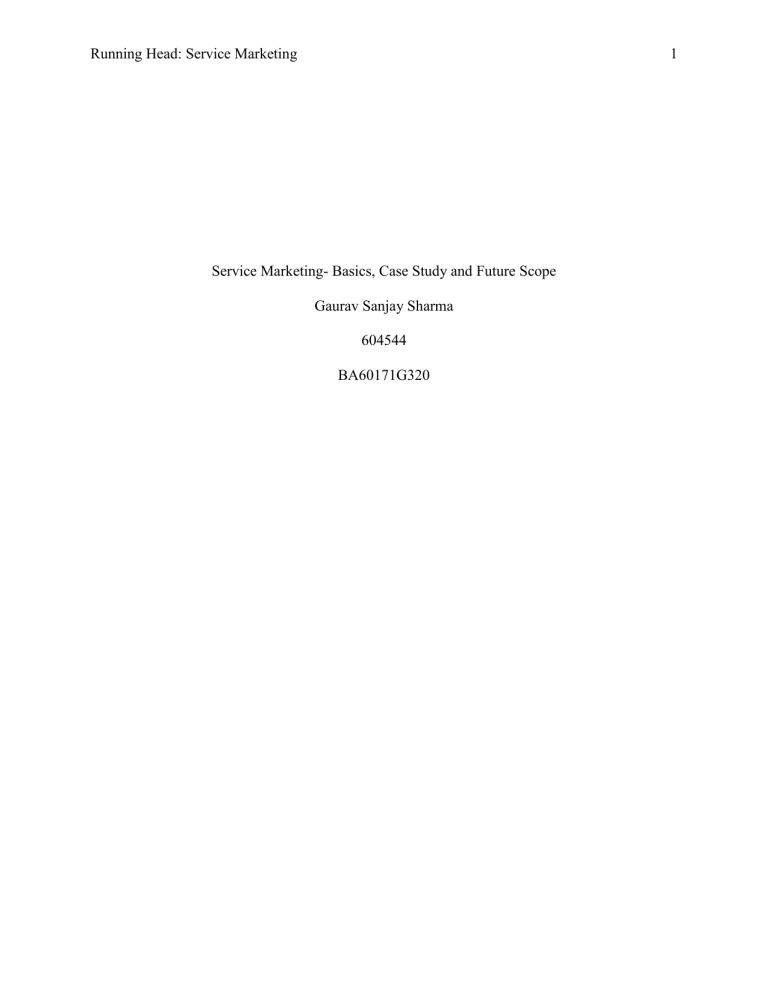
Running Head: Service Marketing 1 Service Marketing- Basics, Case Study and Future Scope Gaurav Sanjay Sharma 604544 BA60171G320 Service Marketing 2 Abstract In this report, the aim is to start off by providing a brief introduction on Services and how do they differ in comparison to a product or a good, which lays the foundation of service marketing. The report moves towards understanding Service Quality, why is it important and a framework to measure the quality of a service. Next, Service Marketing Mix is introduced and an understanding is provided on how it differs from a Product or Good Marketing Mix. The conceptual understanding is utilized to understand the marketing efforts from the service marketing mix lens for one of the logistics supply brand DHL. The report ends with discussion on what is the future scope of Service Marketing and Research and aims to target popular beliefs around problems and strategies in Service Marketing Service Marketing 3 Service Marketing- Basics, Case Study and Future Scope Marketing as a domain can be broadly classified into two umbrellas: Marketing a Product versus Marketing a Service. In the economic setup of the market today, the service industry has grown into a powerful entity, dominate a majority of it. Hence, understanding the marketing perspective of the Service Industry is equally important for marketing professionals. A service typically differs from a product or a good based on four unique characteristics, namely Intangibility, Inseparability, Heterogeneity and Perishability. A service is said to be intangible as the customer consuming the service does not have a palpable form to feel or touch once purchased. The production and consumption of a service happen at the same time. Unlike goods which typically have a manufacturing date and an expiry date, service production and consumption are inseparable. A buyer and a seller have to be in the same environment for the service production and consumption to take place. A physical good has characteristics which make it easier to differentiate against the one produced by a competitor. Also, a physical good produced by a firm have almost similar characteristics which is not the case with services. Since service production and delivery involves human intervention, the service characteristics have a higher probability of not being the same, making heterogeneity a characteristic for a service which can vary over time. A good, for example a vegetable produced, as an expiry date and can be stored in the correct conditions if not consumed immediately. In case of a service, the produced service cannot be stored by a customer for a future use and has to consumed while it is being produced. (Satpathy, Patnaik & Kumar, 2017). The quality of a service is an important phenomenon in services marketing as consumers usually really on the quality indicator numbers to base their expectations and satisfaction levels. Service Quality can be broadly classified into two types: Technical Quality and Functional Service Marketing 4 Quality. Technical Quality deals with aspects of what the customer should be receiving while consuming the service whereas functional quality deals with how the service is delivered. A flipside to measurement of how good a service is that the customer himself/herself have to define whether it is top quality service or not. This has made the measurement process difficult. Hence, marketers consider interviewing customers to understand their expectations and what is currently wrong in their delivery process to make improvements in it. SERVQUAL is a service quality measurement framework which utilizes multiple criteria to measure the expectation of a customer from the service. These include consumer expectation-experience discrepancy, mismanagement of differences, service design, delivery methods and important communications pertaining to the service. This model helps marketers measure and understand what is needed from the customer and identifying gaps in the current process. The next steps for the service firm is to formulate solutions to reduce or remove these gaps so that the customer’s actual expectations are met. (Satpathy, Patnaik & Kumar, 2017). When a marketing professional thinks of strategies of marketing a product or a service, utilizing the marketing mix is the first approach that he or she adopts while devising the marketing plan. For a Product or Good, the 4Ps of Product, Price, Promotion and Place are mixed in appropriate proportions to market the product to a prospective customer. However, when marketing a service, three additional factors need to be considered, given the difference in the characteristics of a product and a service. Process, People and Physical Evidence complete the extended marketing mix, comprising of 7Ps. The decision of how these factors would be weighed upon while creating a mix is largely influenced by the positioning of the firm in the domain. Positioning is typically defined as the process of developing the mix to influence the Service Marketing 5 potential customers by creating an image about the service line, brand and the organization. (Oflac, Dobrucal, Yavas & Escobar, 2015). One of the important pillars of a marketing mix is the Place. In the service marketing domain, servicescape is the Place factor which influences the expectations and satisfaction criteria for a customer. In layman terms, servicescape is a place where the buyer and seller of the service interact with each other. Service is assembled in the environment and consumed by the buyer on the fly. A servicescape concept covers the interior design issues, inclusive of layout, equipment and décor, external physical environment and color, lights and background music of the consumption location which influences the meaning a consumer might derive about the intangible service which can consumed in the environment. The physical factors of a servicescape include the Symbolic Information available, documentation and other artifacts for guiding a user and the spatial layout of the environment. Gender is another factor considered while setting up a servicescape for the service consumption. Correct signs and symbols give the user cues pertaining to service consumption. A correct spatial layout helps the consumer understand the service arrangement. Servicescapes also have to consider the target markets. Another important aspect for marketers to consider while setting up a servicescape is that along with the physical factors, human interaction inside the servicescape also influence the interactions. Multiple actors such as an employee or a customer react emotionally, cognitively or physiologically to the servicescape setup in their interactions with each other. Since, this is more of a background process, many marketers fail to acknowledge its influence. (Nilsson & Ballantyne, 2014). Continuing the discussion around the Service Marketing Mix and its impact on service-based firms, logistics industry is one of the most influenced industry in context of marketing. A few Service Marketing 6 reasons include the competitive edge gained if the right marketing efforts are placed, cost reduction and resource access and management. Logistics firm need their marketing to be on the point as there are numerous competitors offering the same services but customers choose only a few. Deutsche Post DHL, one of the leading names in logistics was analyzed for its marketing efforts. The analysis was done with the help of interviews with multiple stakeholders such as Air Freight Supervisor, HR Lead and Sales Managers as well as the marketing numbers were utilized for data analysis. Based on the findings in the interviews, the findings were classified into the 7Ps of the extended marketing mix. 1. Service: DHL provided multiple services which were divided across their divisions. The company aims to build long-term relationships versus just aiming to win a contract. Their solutions are available as standard which can customized as per the requirement of the customer as well. 2. Price: Multiple pricing strategies have been established based on the criticality of the goods transported and cost incurred to handle them as well. Pricing also varies between the selection of a standardized option versus a customized option. Since the focus of the brand is on maintaining long-term relationships, loyal customers have reduced pricing based on the number of years of association as well 3. Promotion: DHL utilizes Television Advertisement to promote their offers to the people. Another promotional strategy utilized by the firm is through sponsorship deals with top brands such as Manchester United, IMG Fashion Week etc. In recent years, DHL has also been involved in socially responsible activities, promoting the Go Green initiatives to inform their customers that they prefer providing the service keeping the environment in mind Service Marketing 7 4. Place: The company has a global presence, providing services across all their divisions in over 150 countries across the globe. Their distribution channel members are selected keeping only one objective in mind- Meeting Promised Requirements 5. People: Every employee joining the company has to go through personnel training and tailored communication skill development to meet the said requirements while dealing with their customers. Employees are also trained on software tools which they need in their daily job 6. Physical Evidence: The company makes an effort to utilize the logo and brand information on various collaterals such as an employee card, a brochure for a prospective client as well as the invoices generated so that it leaves a mark that this is related to DHL 7. Processes: For DHL, customer satisfaction has always been a top priority. All of their customer complaint calls are stored and analyzed to identify the root cause of the situation and the next steps are provided immediately so that the customer’s experience is great and they would not worry about what’s next for them. Delivery Duration, Route Analysis of the drivers are also analyzed with an attempt to reduce the delivery time and provide the customer a faster access to their requested goods as a part of their process. (Oflac, Dobrucal, Yavas & Escobar, 2015). This process did provide the research a glimpse of the efforts taken by the company to maintain the brand name at the least and also work on improving it further. Currently in Service Marketing, the concept of value co-creation has been a top priority for the researches and multiple efforts are being taken to establish practical applications of the concept. Services Research has been aimed to perform two tasks: Understanding the customer better and How to develop service relationships based on trust and resource Service Marketing 8 integration. Since the start of the millennium, there has been a push in the efforts to understand that service firms have become customer-oriented versus becoming more profitcentric. The concept of value in service research has always been economical where value-inexchange was derived by the profits on completion of the transaction. Value-in-context and Value-in-experience are two perspectives which have shifted the way Value is viewed in Service Marketing. Multiple theories have been proposed such as Service Dominant Logic (S-D Logic), Customer-Dominant Logic (C-D Logic) and Service Logic which have theoretically supported the value-in-context and value-in-experience notions of Service Marketing. These notions have bought into light the need for understanding that the value in Service Delivery is co-created by the customer and the provider. This value co-creation is also supported by the simplest definition of a service which states that Service is the application of competences such as Knowledge and Skills for the benefit of the other party. The theories help in proving that value-in-exchange is not the basis of service, rather valuein-context and value-in-experience is but the empirical support for these theories is still under to be provided by the Service Researchers. (Hansen, 2019). In the service marketing realm, the emphasis has always been on understanding the differences between the strategies to market a good versus market a service. In contrast, marketers as well as research professionals now second the fact that service marketing firms have distinctions amongst themselves as well. These distinctions can be broadly classified into four categories including customer grouping, geographical existence of the firm, duration of the service provided and the presence of the customer in the servicescape. (Zeithaml, Parasuraman & Berry, 1985). Service Marketing 9 In conclusion, service marketing strategies and problems should not be generalized since the service firms vary in the way they individually function. Although certain characteristics remain the same, the differences need to be recognized while performing research and analysis on problems and designing solutions to counter them. Service Marketing 10 References: 1. Hansen A.V. (2019). Value co-creation in service marketing: A critical (re)view. International Journal of Innovation Studies, Vol. 3, 73-83 2. Nilsson E. & Ballantyne D. (2014). Reexamining the place of servicescape in marketing: a service-dominant logic perspective. Journal of Service Marketing, Vol. 28, Issue 5, 374-379 3. Oflac B.S., Dobrucal B., Yavas T. & Escobar M.G. (2015). Service Marketing Mix Efforts of a Global Services Brand: The case of DHL Logistics. Procedia Economics and Finance, Vol. 23, 1079-1083. 4. Sathpathy I., Patnaik B. C. M., Kumar S. (2017). Service Marketing and Service Quality – A Conceptual Framework. International Journal of Research in Management, Economics and Commerce, Vol. 7, Issue 12, 74-80 5. Zeithaml V.A., Parasuraman A.P. & Berry L.L. (1985). Problems and Strategies in Service Marketing. Journal of Marketing, 49(2), 33-46.
